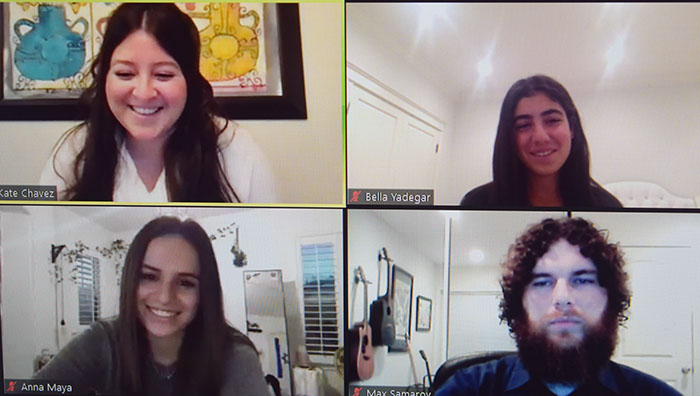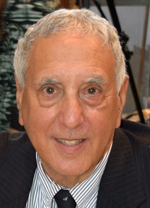
By Donald H. Harrison

SAN DIEGO – The stories of Sephardic and Mizrachi Jews who came to the U.S. from the Middle East should be included in the Asian-American Studies section of California’s proposed Ethnic Studies Model Curriculum that goes before the State Board of Education on Thursday, March 18, panelists sponsored by the pro-Israel organization, StandWithUs (SWU), said Wednesday.
At this point, according to the panelists, the Asian-American Studies section of the proposed model curriculum includes stories of Arab-Americans, but leaves out many other groups that have also dwelled in the Middle East for centuries including Jews, Kurds, and Persians, among other peoples.
Two high school students who served on the panel, in fact, traced their roots to Asian Jewish communities. Anna Maya, a student at Bonita Vista High School in Chula Vista, is a descendent of Syrian and Turkish Jews who settled initially in Mexico, and later migrated to San Diego County, where they helped to establish the Spanish-speaking Ken Jewish Community. Bella Yadegar, a student at Brentwood School in Los Angeles, is part of a family of Persian Jews who fled Iran to Israel because of anti-Jewish discrimination, and later immigrated to the U.S.
The panel, moderated by Kate Chavez, StandWithUs’s associate director of high school affairs, featured Max Samarov, StandWithUs’ executive director for research and strategy. He said while the Middle Eastern section of the proposed Asian-American curriculum properly inveighs against Islamophobia in the United States, it is silent about anti-Semitism, which he described as “problematic.”
In addition to calling for the inclusion of the heritage and problems of Jews from the Middle East in the main section of the curriculum, Samarov said it’s important to block efforts to reinsert what he described as anti-Zionist, pro-Boycott, Divestment and Sanctions (BDS), and even antisemitic material into the model curriculum and local school districts.
The Ethnic Studies Model Curriculum for high schools has been revised several times as Jewish groups have battled anti-Israel activists over the wording in the proposed curriculum. The state Legislature was so alarmed by the anti-Israel tone of the first draft of the model curriculum that it ordered it to be thrown out and revised to remove antisemitic material. Samarov said the problems in the first draft were the result of bias among a faction in the field of ethnic studies, as evidenced by the Critical Ethnic Studies Association’s institutional support of BDS. While the second draft was being prepared, the supporters of the first draft lobbied local school boards to nevertheless support the first draft.
While StandWithUs agrees that attention should be paid to underrepresented communities – such as Asian-Americans, African-Americans, Latinx-Americans, and Indigenous Americans—the curriculum should be positive, uplifting, inclusive and not tear down other communities, according to Samarov.
Maya and Yadegarillustrated how important an inclusive curriculum is to teach students to honor and respect students with different ethnic backgrounds. In her sophomore year, Maya said she found a swastika engraved on the back of a stall in a woman’s restroom. Just two months ago, she said, her 15-year-old sister was participating on line in a discussion of the “Green Revolution,” when someone else crashed into the discussion and renamed it “Hitler Did Nothing Wrong.” The sister’s teacher immediately intervened, saying hate would not be tolerated at the school.
Yadegar said she has a teacher who described 1948, the year Israel became an independent nation, as a “year of disaster” and excoriated Zionism as an extreme form of nationalism. She said those comments made her feel “excluded,” especially because a refuge in Israel may have saved the lives of members of her family. She said a relative was made to sit in the back of class at her school in Iran, because classmates didn’t want the “dirty Jewess” to rub off on them. In such a climate, the family fled to Israel. She said the exclusion of material about Jews and others peoples of the Middle East seems like “efforts to erase their identity.”
Both Maya and Yadegar are involved in Israel Clubs at their schools, through which students can learn about Jewish and Israeli history. However, if ethnic studies are taught in schools, course material about their history – not only about Arab-Americans – ought to be taught, panelists said.
Those who wish to make their views known to the State Board of Education may do so via email at sbe@cde.ca.gov or by calling 916-319-0827 by Friday, March 12. Emails should include the commenter’s first and last name, organizational affiliation, if any, and the number of the item {#9) being commented upon.
Here is a link to the State Board of Education’s agenda. Item 9, on Day 3 (March 18) has an attachment discussing recommended changes to the curriculum.
The members of the State Board of Education are Linda Darling-Hammond, President; Ilene W. Straus, Vice President; Sue Burr, Cynthia Glover-Woods, Jim McQuillen, Mattt Navo, Kim Pattillo Brownson, Haydee Rodriguez, Patricia A. Rucker, Ting L. Sun and student member Zaid Fattah. The Board’s Secretary and Executive Officer is State School Superintendent Tony Thurmond.
*
Donald H. Harrison is editor of San Diego Jewish World. He may be contacted via donald.harrison@sdjewishworld.com